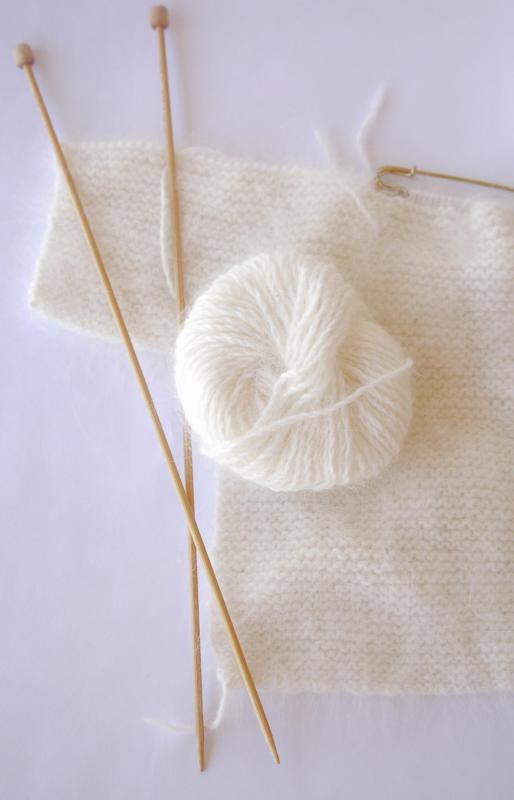At AllThingsNature, we're committed to delivering accurate, trustworthy information. Our expert-authored content is rigorously fact-checked and sourced from credible authorities. Discover how we uphold the highest standards in providing you with reliable knowledge.
What are Angora Rabbits?
Angora rabbits are characterized by their long, fluffy fur, famous for its use in sweaters and other clothing. In addition to their contribution to the textile industry, Angora rabbits are bred to show and as pets. In the 18th century, Angora rabbits were popular among the French royalty as pets. They are thought to have originated in Turkey, and their name derives from Ankara, Turkey's capital city. Because Angora rabbits are an old breed, they are not as skittish as some other rabbits and take well to human company.
Angora wool is very warm and very light at the same time. However, the fur must be blended with other textiles, because Angora fibers are too fine to hold together on their own. Angora wool is harvested without harming the rabbit, either by combing or gentle shearing, depending upon the breed.

There are five types of Angora rabbit, but the American Rabbit Breeders' Association (ARBA) recognizes only four: the English, French, Satin, and Giant Angora rabbits. The fifth breed is the German Angora rabbit. Since German Angora rabbits are not currently recognized by ARBA, another club was created in the United States solely for this breed, the International Association of German Angora Rabbit Breeders (IAGARB). Some consider German and Giant Angora rabbits to be a single breed.

English Angoras are the smallest Angora rabbits and the most popular as pets. They feature fluffy fur on the face and ears as well as the body, and they require a lot of combing, as their fur is prone to matting. French Angora rabbits are easier to take care of, because their fur includes a top coat of guard hairs that are not as likely to mat as the fluffy undercoat. French Angora rabbits also differ from the English variety in that their face and ears are free of fur. Some French Angoras have ear tassels, or tufts of fur on the ends of the ears, but this is not considered a desirable trait among breeders.
Frequently Asked Questions
What are Angora rabbits?
Angora rabbits are a distinctive breed known for their long, soft wool, which is highly prized for its warmth and fluffiness. Originating from Ankara, Turkey, these rabbits are one of the oldest types of domestic rabbit. They are bred primarily for their fiber, which can be spun into yarn, but they also make gentle and affectionate pets.
How many types of Angora rabbits are there?
There are several types of Angora rabbits, but the four most recognized by the American Rabbit Breeders Association (ARBA) are the English, French, Giant, and Satin Angoras. Each type has unique characteristics, such as the English Angora's full facial furnishings, known as a "muff," and the Satin's lustrous sheen.
What is the maintenance like for an Angora rabbit's coat?
Angora rabbits require extensive grooming due to their long wool. Owners should brush their rabbits' coats several times a week to prevent matting and tangling. Additionally, Angoras need regular haircuts every few months to keep their wool manageable and to ensure the rabbits do not ingest too much hair, which can lead to wool block.
How much wool can an Angora rabbit produce?
An Angora rabbit can produce an impressive amount of wool, with some rabbits yielding up to 1 pound of fiber per year. The actual amount depends on the breed, with the Giant Angora, for instance, producing more wool due to its larger size. Regular harvesting of the wool is essential for the rabbit's health and comfort.
Are Angora rabbits good pets?
Angora rabbits can be excellent pets for individuals or families willing to commit to their care. They are known for their docile and friendly nature, making them suitable for households with children. However, potential owners must be prepared for the high level of maintenance their wool requires, including regular grooming and the potential for health issues related to their fiber.
What should I feed my Angora rabbit?
A balanced diet for an Angora rabbit should consist of high-quality rabbit pellets, fresh hay, clean water, and occasional vegetables as treats. Hay is particularly important as it provides the necessary fiber to prevent wool block, a common health issue in Angoras. A proper diet will also help maintain the quality and health of their wool.
AS FEATURED ON:
AS FEATURED ON:












Discuss this Article
Post your comments